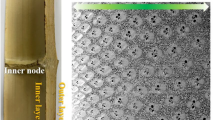Abstract
Bamboo utilization is restricted by its tubular culm. An attempt was made to understand flattening mechanisms of a half-tubular bamboo culm in hot linseed oil. The half tubular culm of Dendrocalamus asper Backer was pressed into a flatter shape under a constantly applied load while being softened in hot linseed oil. Specimen height, used to calculate the degree of flatness, was recorded as a function of time. Effects of linseed oil temperature (80–180 °C) and properties of bamboo specimens, i.e. initial moisture content (0–46 %), volume fraction of vascular bundles (35–55 %) and thickness (3–5 mm), on the flattening behavior were examined. The presence of moisture in bamboo reduced the temperature at which deformation began and increased the final board flatness. Higher volume fraction of vascular bundles reduced the rate of deformation. Linseed oil temperature of at least 120 °C was required to achieve good quality flat boards and to avoid immediate springback after load removal. Flattening of relatively thick bamboo specimens was limited as a result of non-uniform softening throughout the specimen thickness.







Similar content being viewed by others
References
Boresi AP, Schmit RJ, Sidebottom OM (1993) Advanced mechanics of materials. Willey, New York
Cherdchim B, Matan N, Kyokong B (2004) Effect of temperature on thermal softening of black sweet-bamboo culms (Dendrocalamus asper Backer) in linseed oil. Songklanakarin J Sci Technol 26:855–866
Dubey MK, Pang S, Walker J (2011) Changes in chemistry, color, dimensional stability and fungal resistance of Pinus radiata D. Don wood with oil heat-treatment. Holzforschung 66:49–57
Glasser WG, Rials TG, Kelley SS, Dave V (1998) Studies of the molecular interaction between cellulose and lignin as a model for the hierarchical structure of wood. In: Heinze TJ, Glasser WG (eds) Cellulose derivatives modification, characterization, and nanostructures. American Chemical Society, Washington, pp 265–282
Hansson L (2007) Microwave Treatment of Wood. Dissertation. Luleå University of Technology
Haygreen JG, Bowyer JL (1989) Forest products and wood science. Iowa State University Press, Iowa
Lenth CA (1999) Wood Material Behavior in Severe Environments. Dissertation, Virginia Polytechnic Institute and State University, USA
Li X (2004) Physical, chemical, and mechanical properties of bamboo and its utilization potential for fiberboard manufacturing. Dissertation, Louisiana State University
Liu Z, Jiang Z, Cai Z et al (2012) Dynamic mechanical thermal analysis of moso bamboo (Phyllostachys heterocycla) at different moisture. Bioresouces 7:1548–1557
Liu J, Zhang H, Chrusciel L, Na B, Lu X (2013) Study on a bamboo stressed flattening process. Eur J Wood Prod 71:291–296
Machado JS (2006) Effect of microwave treatment on oak compression strength. Silva Lusitana 14(1):51–58
Mahdavi M, Clouston P, Arwade SR (2012) A low-technology approach toward fabrication of laminated bamboo lumber. Constr Build Mater 29:257–262
Malanit P, Barbu MC, Frühwald A (2009) Mechanical properties of sweet bamboo (Dendrocalamus asper Backer). J Bamboo Ratan 8(3&4):151–160
Manalo RD, Acda MN (2009) Effect of hot oil treatment on physical and mechanical properties of three species of Philippine bamboo. J Trop For Sci 21:19–24
Matan N, Kyokong B, Preechatiwong W (2007) Softening behavior of black sweet-bamboo (Dendrocalamus asper Backer.) at various initial moisture contents. Walailak J Sci Technol 4:225–236
Mori M (1987) Process of flattening bamboo pieces utilizing microwave heating. Mokuzai Gakkaishi 33:630–636
Oloyede A, Groombridge P (2000) The influence of microwave heating on mechanical properties of wood. J Mater Process Technol 100:67–73
Parkkeeree T, Matan N, Matan N, Kyokong B (2014) Flattening of half tubular bamboo culms and fixation of bamboo boards. J Trop For Sci 26:101–114
Passard J, Perré P (2005) Viscoelastic behaviour of green wood across the grain. Part I thermally activated creep tests up to 120 °C. Ann For Sci 62:707–716
Placet V, Passard J, Perré P (2008) Viscoelastic properties of wood across the grain measured under water-saturated conditions up to 135 °C evidence of thermal degradation. J Mater Sci 43:3210–3217
Sandberg D, Navi P (2007) Introduction to thermo-hydro-mechanical (THM) wood processing. Växjö University Press, Sweden
Sutnaun S, Srisuwan S, Jindasai P, Cherdchim B, Matan N, Kyokong B (2005) Macroscopic and microscopic gradient structures of bamboo culms. Walailak J Sci Technol 2:81–97
Wolcott MP, Kamke FA, Dillard DA (1990) Fundamentals of flake board manufacture: viscoelastic behavior of the wood component. Wood Fiber Sci 22:345–361
Acknowledgments
The authors acknowledge the support from Walailak University Fund and the Wood Science and Engineering Research Unit, Walailak University, Thailand. One of the authors (TP) wishes to thank King Mongkut’s University of Technology North Bangkok, Thailand for a scholarship to study Ph.D. at Walailak University.
Author information
Authors and Affiliations
Corresponding author
Rights and permissions
About this article
Cite this article
Parkkeeree, T., Matan, N. & Kyokong, B. Mechanisms of bamboo flattening in hot linseed oil. Eur. J. Wood Prod. 73, 209–217 (2015). https://doi.org/10.1007/s00107-015-0889-x
Received:
Published:
Issue Date:
DOI: https://doi.org/10.1007/s00107-015-0889-x




